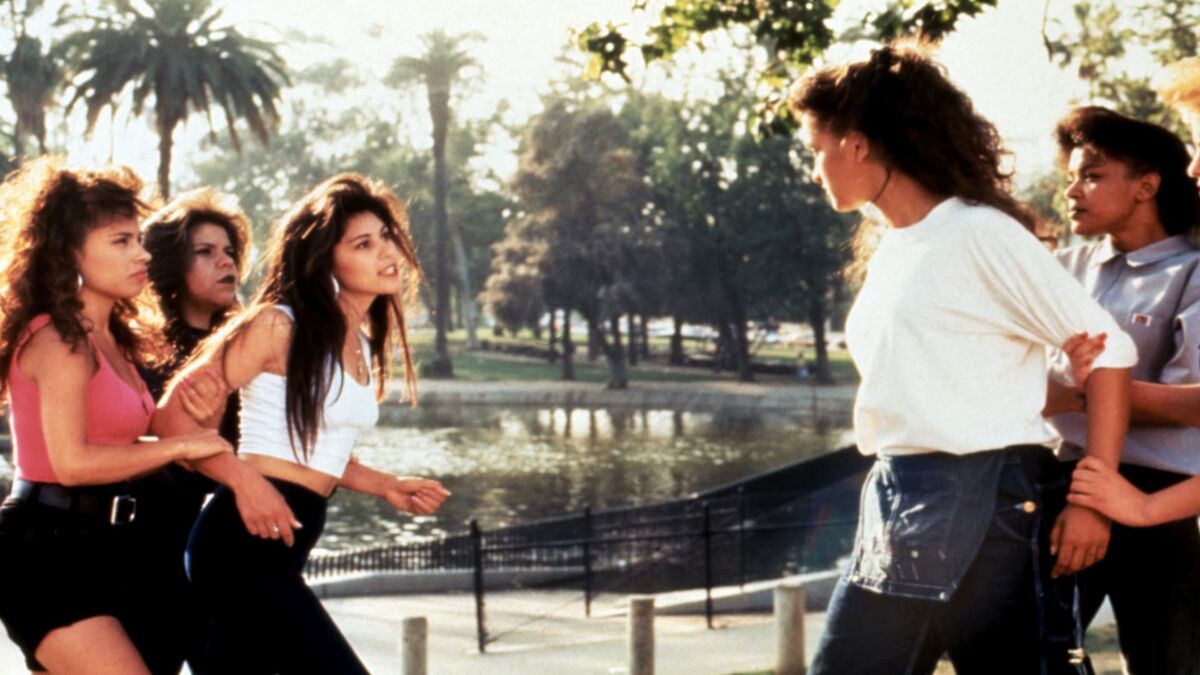In 1993, a movie dropped that has since become a chola, Chicana, and Latinx cult classic: Mi Vida Loca.
Set in Echo Park, Los Angeles, it follows the lives of best friends Mousie and Sad Girl along with the other homegirls in their crew, as they navigate life, love, family, gang life, and their friendships. This Allison Anders film is something that represented SoCal chola culture for so many, and introduced or reinforced it for so many other Latinas and non-Latinas alike. As it celebrates its 30th anniversary, we are going to look at the many reasons why it has become a Latina cult classic.
The Look

Let’s start with the style, shall we?
Mi Vida Loca showcases what true cholas and cholos were rocking in LA (and beyond) during the 1990s. We’re talking Cortez sneakers, shadow plaid flannel, webbed bracelets, big-ass hoops, tank dresses, Ben Davis shirts, hairnets, overalls, Dickies pants, and more. For women, it was that dope combination of men’s workwear balanced with feminine touches, including big Aqua-Netted hair, winged eyeliner, and dark burgundy lipstick. Wherever you were, you were probably influenced by the style in Mi Vida Loca. I know that the Latinas–myself included–at my bougie all-girl Catholic high school in Burlingame, CA were trying to look and act like we were about that life.
The Language
Which leads us to the lingo, since a big part of any culture is its language. By watching Mi Vida Loca, you learn about Chicano Caló words like “vato,” which means “guy,” “hyna,” which translates to “girlfriend,” “leva,” which means “coward,” and more. We hear the fierce and cool accent, and the effortless use of Spanglish (we may have even copied it). We also witness other elements of cholo culture, such as the classic lowriders with their majestic mini murals (the one in the film was called “Suavecito,” after the Oldies song by SF band Malo), the beautiful Chicano prison artwork that flourished on correspondence, the throwback Oldies music, and the generational differences between the pachucas, the ‘80s homegirls, and what ‘90s girls like Whisper, Mousie, and Sad Girl were dealing with.
The Struggle

Which was a lot. No doubt the most important thing to learn from Mi Vida Loca is while many of us were (or are) playing dress up by wearing big hoops and dark lipstick, throwing out words to look tough and mean mugging other girls to show we aren’t ones to be messed with, real cholas are actually dealing with their harsh realities. The movie shares how cholos can be lured into gangs and the easy-money that comes from selling drugs. How the women who love them are often left alone to be the badasses raising their kids and holding it down for their family. How loyalty means everything–and this can both heal and destroy lives. And we see how those who are at the wrong place at the wrong time can end up in prison–or dead.
The Cast
Mi Vida Loca wouldn’t be the cult classic it is without its actors. A great thing about this film is that it is Latinx actors, many of whom are Mexican/Chicano, playing Latinx roles. Did you know that Mi Vida Loca was Salma Hayek’s first movie?! It was! We also got to see great Latinx talent like Danny Trejo, Angel Aviles, Seidy Lopez, Jacob Vargas, and Jesse Borrego.
The Authenticity

Alison Anders went the extra step to make sure the chola and cholo narratives were accurate. According to Screen Slate, she consulted with actual gang members from Echo Park to make sure everything was on point: “They were involved and paid and credited in every single department in post and production. We even kept the money in the neighborhood literally – the art department rented set dressing from their homes – which also gave a sense of pride that a movie company was renting some banner they made for their bedroom to put on film. We rented the homes of the parents and grandparents of the Echo Park locas and locos. Make-up purchased the real stuff the actual girls wore from Woolworth’s on Sunset Blvd.”
The Soundtrack
It’s definitely time to talk about the soundtrack. Duuuude! It was good! I personally had it on cassette tape. The track listing includes jams from A Lighter Shade of Brown (“Hey DJ” and “Two Lovers”), and Tony Toni Tone (“Weather 4 2”), a remake of the song “Suavecito,” and another song from 4 Corners called “Girls It Ain’t Easy” that will have you belting out the lyrics of female empowerment in no time.
The Message

Which brings me to my final point about Mi Vida Loca and its importance. Female empowerment. These homegirls were about loyalty, solidarity, and lifelong friendship. They took care of their kids, navigated difficult relationships with men, and figured out how to deal with other loved ones. They managed to survive in their tough environment when people were dying to the left and right of them. When OG chola Giggles comes out of jail after serving four years for holding it down for her man, she stresses the importance of learning skills (she pushes the idea of learning computers, as it is going to be the next big thing), because depending on guys is not where it’s at. Giggles points out that these guys often end up in “prison, disabled, or dead.” Cholas, Chicanas, and Latina women everywhere have come to learn that although we were raised in a macho patriarchy, the women are the ones who have always run the show, made sure everyone was okay, and persevered with strength, faith, and love. Mi Vida Loca helps drive that important point home.
So, happy 30th anniversary to Mi Vida Loca, the film that has become a cholatastic classic! Thank you for entertaining us, educating us, and showing us a true glimpse at chola life.

